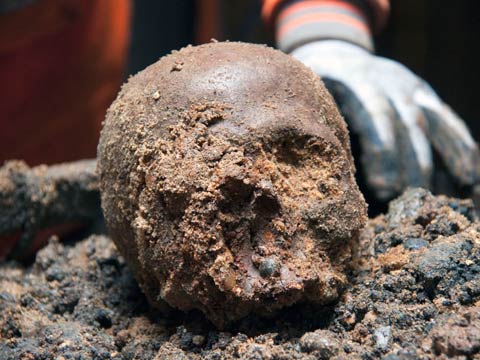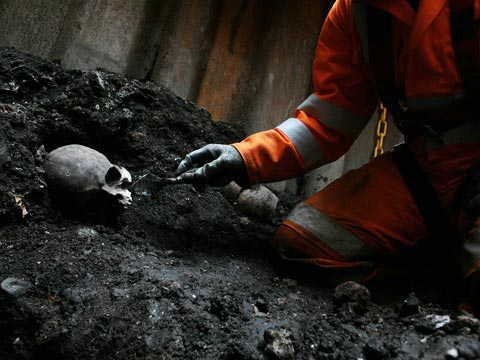Almost 2,000 years ago somebody neatly packed cremated human bones into an old cooking pot, put the lid on, and set it by the banks of a smelly little urban river, the Walbrook in London. The discovery has deepened the mystery of scores of Roman skulls found nearby, polished till they gleam by tumbling among the pebbles of the riverbed.
It had been suggested that the skulls ended up in the river – which vanished into culverts centuries ago – by accident, eroded out of a Roman cemetery and washed downstream until they came to rest at bends in the bank. The new finds suggest a grimmer explanation.
Jay Carver, Crossrail’s lead archaeologist on the site yards from the bustling commuters at Liverpool Street station, said the thrifty reuse of the old pot, and its deliberate placing by the river, will force archaeologists to look again at the skulls found in this excavation and generations of previous digs around the river.
“We now wonder again if the skulls were deliberately placed on the banks. Certainly no river ever carried off the cooking pot with its cremated bones which was unquestionably deliberately placed here. And the horse skull we found with one of the skulls didn’t come out of some equine graveyard, that was clearly also placed there,” he said.
The finds are now beginning to suggest gruesome ritual deposits of skulls, set along the river bank as offerings and boundary markers. Scientific tests are continuing on both the cremated remains and the skulls, and may confirm an early theory that most are the heads of young men who may have been executed criminals and rebels. Some could even be from the major rebellion Boudicca, queen of the Iceni tribe, led in the first century of Roman rule.
“I think we now have to look back at earlier finds in this area – we have found 40 human and two horse skulls, but if you add them up over the last two centuries you’re talking hundreds of skulls in a very small area – and try and work out what is actually going on,” Carver said.
This one small site, part of a massive archaeology programme as Crossrail carves its route across the capital and through two millennia of its history, has produced a mass of Roman and medieval objects, as well as thousands of skeletons from a 17th-century burial ground which became the last resting place of thousands of victims of the last great plague of London in 1665.
Finds include 15 Roman iron horseshoes, more than from any other London site – expensive objects which the archaeologists assume were accidentally shed and then trampled into the surface of the road. “They would have been expensive to make and expensive to replace, but they were obviously clunky, clumsy affairs – and clearly they hadn’t perfected the technique of getting them to stay on,” Carver said.
A little gilt bronze phallus, a valuable lucky charm, was probably lost when the ring holding it to a belt or garment broke, and a shackle just the right size to secure an ankle is a reminder that slavery was a pillar of the Roman empire.
The road leading to the river was an excellent example of Roman engineering, part of what Carver describes as the North Circular passing all the main gates in the city walls. It was heavily used, regularly repaired, and completely resurfaced at least three times, preserving cart ruts several layers below the final surface.
For more than 1,000 years the site was a grotty, smelly bit of working-class London outside the city walls, a place where no travellers on the Roman road would have wanted to linger. On Thursday, a digger punched through the floor of what was a 19th-century underground lavatory, releasing a pungent reek of marsh gas and Victorian sewage. The buildings were shoddy structures, probably workshops. Rubbish dumps yielded skiploads of evidence of medieval industries including leather tanning, a notoriously smelly trade.
The land became the gardens and orchards of a medieval monastery complex which became the famous Bedlam mental hospital, the oldest in the world. It was still open land when in 1569 a two-acre plot was bought for a new burial ground because the small city church graveyards were full to bursting. The Bethlem burial ground took its name from the hospital which had recently moved to nearby Moorfields and held not just poor unclaimed inmates of the asylum, but people of all classes from across the capital. It was in use from 1569 until 1738, and so eventually held thousands of victims of the great plague, the last major outbreak which devastated London in 1665.
The archaeologists from Museum of London Archaeology worked all the hours of daylight to excavate the remains, eventually recovering more than 2,500 skeletons, far more than expected from a swimming pool sized site. During the worst plague months, they found people were being buried seven or eight to each pit.
Volunteers are attempting to compile a complete burial list for the cemetery, but when the excavation began Carver was not optimistic about identifying any individuals, as the records were scattered across all the original parishes of the dead.
To his surprise they have found tiny nails from the decayed wood of several coffins which spell out initials and dates. Several broken tombstones have also been found reused in a Georgian wall, including that of Mary Godfree who died at the height of the plague in September 1665.
One small section remains to be excavated this summer, so Carver has not given up all hope of finding two of the most famous people known to have been buried there, the Levellers and Cromwellian soldiers John Lilburne and Robert Lockyer. Lockyer was executed by firing squad in 1649 for his radical political beliefs.
“I’ve had to warn the Levellers Association that our site is only about 20% of the original burial ground. But if he was buried in our section, more than 4,000 people are said to have followed his funeral procession – I can’t believe he would have gone into his grave without something to identify his coffin. We might yet find him.”











